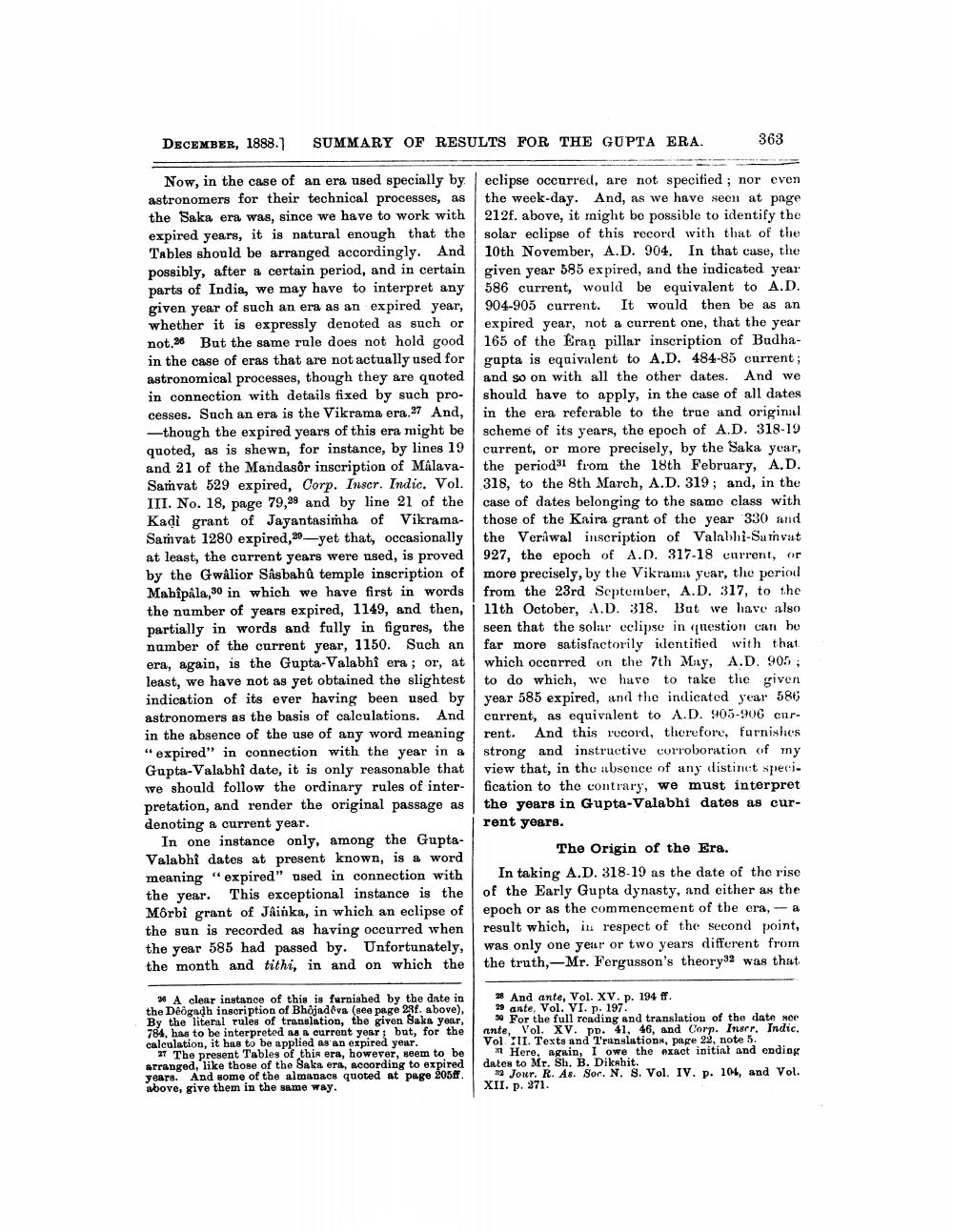________________
DECEMBER, 1888.1
SUMMARY OF RESULTS FOR THE GUPTA ERA.
363
Now, in the case of an era used specially by eclipse occurred, are not specified ; nor even astronomers for their technical processes, as the week-day. And, as we have seen at page the Saka era was, since we have to work with 212f. above, it might be possible to identify the expired years, it is natural enough that the solar eclipse of this record with that of the Tables should be arranged accordingly. And 10th November, A.D. 904. In that case, the possibly, after a certain period, and in certain given year 585 expired, and the indicated year parts of India, we may have to interpret any 586 current, would be equivalent to A.D. given year of such an era as an expired year, 904-905 current. It would then be as an whether it is expressly denoted as such or expired year, not a current one, that the year not.28 But the same rule does not hold good 165 of the Eran pillar inscription of Budhain the case of eras that are not actually used for gupta is equivalent to A.D. 484-85 current; astronomical processes, though they are quoted and so on with all the other dates. And we in connection with details fixed by such pro- should have to apply, in the case of all dates cesses. Such an era is the Vikrama era 27 And, in the era referable to the true and original
-though the expired years of this era might be scheme of its years, the epoch of A.D. 318-19 quoted, as is shewn, for instance, by lines 19 current, or more precisely, by the Saka year, and 21 of the Mandasör inscription of Malava- the period from the 18th February, A.D. Samvat 529 expired, Corp. Inscr. Indic. Vol. 318, to the 8th March, A.D. 319; and, in the III. No. 18, page 79,29 and by line 21 of the case of dates belonging to the same class with Kadi grant of Jayantasimha of Vikrama- those of the Kaira grant of the year 330 and Samvat 1280 expired, 20—yet that, occasionally the Veråwal inscription of Valabhi-Samvat at least, the current years were used, is proved 927, the epoch of A.D. 317-18 current, or by the Gwalior Såsbah û temple inscription of more precisely, by the Vikramı year, the period Mahipala,30 in which we have first in words from the 23rd September, A.D. 317, to the the number of years expired, 1149, and then, 11th October, A.D. 318. But we have also partially in words and fully in figures, the seen that the solar eclipse in question can be number of the current year, 1150. Such an far more satisfactorily identitied with that era, again, is the Gupta-Valabhî era; or, at which occurred on the 7th May, A.D. 90.5; least, we have not as yet obtained the slightest to do which, we have to take the given indication of its ever having been used by year 585 expired, and the indicated year 586 astronomers as the basis of calculations. And current, as equivalent to A.D. 905-906 curin the absence of the use of any word meaning rent. And this record, therefore, furnishes "expired" in connection with the year in a strong and instructive corroboration of my Gupta-Valabhî date, it is only reasonable that view that, in the absence of any distinct specie we should follow the ordinary rules of inter- fication to the contrary, we must interpret pretation, and render the original passage as the years in Gupta-Valabhi dates as curdenoting a current year.
| rent years. In one instance only, among the Gupta
The Origin of the Era. Valabhi dates at present known, is a word meaning "expired” used in connection with In taking A.D. 318-19 as the date of the rise the year. This exceptional instance is the of the Early Gupta dynasty, and either as the Morbi grant of Jainka, in which an eclipse of epoch or as the commencement of the era, - a the sun is recorded as having occurred when result which, it respect of the second point, the year 585 had passed by. Unfortunately, was only one year or two years different from the month and tithi, in and on which the the truth, -Mr. Fergusson's theory32 was that
» A clear instance of this is furnished by the date in the Dêôgadh inscription of Bhojadova (see page 2gf. above), 1 By the literal rules of translation, the given Saka year, 784, has to be interpreted as a current year; but, for the calculation, it has to be applied as an expired year.
I The present Tables of this era, however, seem to be arranged, like those of the Baka era, according to expired years. And some of the almanacs quoted at page 205ff. above, give them in the same way.
> And ante, Vol. XV. p. 194 ff. 29 ante, Vol. VI. p. 197
3. For the full reading and translation of the date me ante, Vol. XV. pp. 41, 46, and Corp. Inerr. Indic. Vol II. Texts and Translations, page 22, note 5.
11 Here, again, I owe the exact initial and ending dates to Mr. Sh. B. Dikshit.
22 Jour. R. As. Sor. N. S. Vol. IV. p. 106, and Vol. XII. p. 271.




